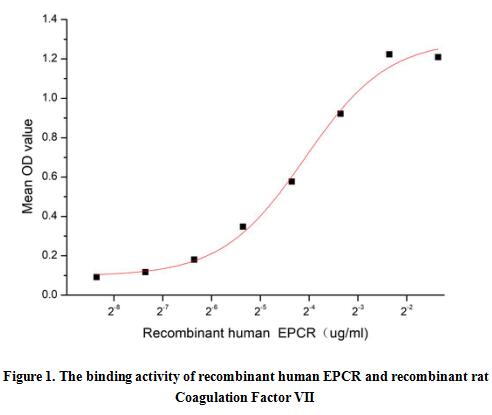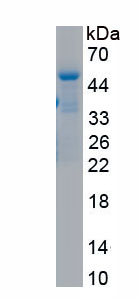Active Endothelial protein C receptor (EPCR) 

CD201; PROCR; CCCA ;CCD41; BA42O4.2; EPCR; Endothelial Protein C Receptor; Cell Cycle, Centrosome-Associated Protein; Activated Protein C Receptor
Overview
Properties
- Product No.APA022Hu02
- Organism SpeciesHomo sapiens (Human) Same name, Different species.
- ApplicationsCell culture; Activity Assays.
Research use only - DownloadInstruction Manual
- CategorySignal transductionCD & Adhesion moleculeHematology
- Buffer FormulationPBS, pH7.4, containing 0.01% SKL, 5% Trehalose.
- Traits Freeze-dried powder, Purity > 80%
- Isoelectric Point6.7
Sign into your account
Share a new citation as an author
Upload your experimental result
Review

Contact us
Please fill in the blank.
Activity test

Endothelial protein C receptor (EPCR) also known as CD201, is a transmembrane glycoprotein expressed on vascular endothelial cells and functions as a negative regulator of thrombosis. It is expressed most strongly in the endothelial cells of arteries and veins in heart and lung. Mature human EPCR consists of a 193 amino acid (aa) extracellular domain (ECD), a 21 aa transmembrane segment, and a 7 aa cytoplasmic tail. Within the ECD, human EPCR shares 63% and 66% aa sequence identity with mouse and rat EPCR, respectively. EPCR inhibits thrombosis through its interactions with Protein C, activated Protein C (APC), and Coagulation Factors VII, and VIIa. Thus a functional binding ELISA assay was conducted to detect the interaction of recombinant human EPCR and recombinant rat Coagulation Factor VII (F7). Briefly, EPCR was diluted serially in PBS with 0.01% BSA (pH 7.4). Duplicate samples of 100 μl were then transferred to F7-coated microtiter wells and incubated for 1h at 37℃. Wells were washed with PBST and incubated for 1h with anti-EPCR pAb, then aspirated and washed 3 times. After incubation with HRP labelled secondary antibody for 1h at 37℃, wells were aspirated and washed 5 times. With the addition of substrate solution, wells were incubated 15-25 minutes at 37℃. Finally, add 50 µL stop solution to the wells and read at 450/630nm immediately. The binding activity of recombinant human EPCR and recombinant rat F7 was shown in Figure 1, the EC50 for this effect is 0.06 ug/mL.
Usage
Reconstitute in 10mM PBS (pH7.4) to a concentration of 0.1-1.0 mg/mL. Do not vortex.
Storage
Avoid repeated freeze/thaw cycles. Store at 2-8°C for one month. Aliquot and store at -80°C for 12 months.
Stability
The thermal stability is described by the loss rate. The loss rate was determined by accelerated thermal degradation test, that is, incubate the protein at 37°C for 48h, and no obvious degradation and precipitation were observed. The loss rate is less than 5% within the expiration date under appropriate storage condition.
Increment services
-
 BCA Protein Quantification Kit
BCA Protein Quantification Kit
-
 Molecular Mass Marker for Protein
Molecular Mass Marker for Protein
-
 Monoclonal Antibody Customized Service
Monoclonal Antibody Customized Service
-
 Polyclonal Antibody Customized Service
Polyclonal Antibody Customized Service
-
 Protein Activity Test Experiment Service
Protein Activity Test Experiment Service
-
 Electrophoretic Mobility Shift Assay (EMSA) Experiment Service
Electrophoretic Mobility Shift Assay (EMSA) Experiment Service
-
 Buffer
Buffer
-
 Lentivirus Packaging Experiment Service
Lentivirus Packaging Experiment Service
-
 Adenovirus Packaging Experiment Service
Adenovirus Packaging Experiment Service
-
 Real Time PCR Experimental Service
Real Time PCR Experimental Service
-
 Spike RBD Protein (S-RBD)
Spike RBD Protein (S-RBD)
-
 Protein G
Protein G
-
 Protein A
Protein A
Citations
- СОВЕРШЕНСТВОВАНИЕ ЛЕЧЕБНО-ДИАГНОСТИЧЕСКИХ МЕРОПРИЯТИЙ ПРИ ГРИППЕ ВО ВРЕМЯ БЕРЕМЕННОСТИBulletin: E2015-1
- Unfractionated heparin protects the protein C system against lipopolysaccharide‑induced damage in vivo and in vitro10.3892/etm.2017.5236
- Effects and mechanisms of PSS-loaded nanoparticles on coronary microcirculation dysfunction in streptozotocin-induced diabetic cardiomyopathy ratsPubmed: 31715373
- Effect of Nitinol on Metabolic and Coagulation Activity of Endothelial Cells Culture34542754







